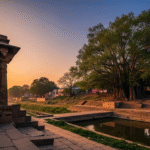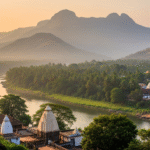Did you know that the Agra Fort is huge? It spans 94 acres. That’s bigger than both the Red Fort in Delhi and Lahore Fort in Pakistan. This place is not just any monument. It’s a big deal from the Mughal era. It has stories of old kings, amazing architecture, and secrets from centuries ago.
Emperor Akbar built Agra Fort in 1565. It has been a military base and a royal home. It’s also a symbol of power. The walls are 70 feet tall. This amazing place is by the Yamuna River. It tells stories of Shah Jahan and Mumtaz Mahal too. The fort shows the rich culture of India.
Key Takeaways
- The Agra Fort extends over 94 acres, surpassing the size of the Red Fort in Delhi and Lahore Fort in Pakistan.
- Constructed by Emperor Akbar in 1565, this site has served various purposes including a military base and a royal residence.
- With walls towering at 70 feet, Agra Fort radiates an aura of unmistakable grandeur.
- Recognized as a UNESCO World Heritage site, it stands as a testament to the Mughal Empire’s architectural brilliance.
- Tales of confinement, love, and political intrigue lend Agra Fort a unique historical charm.
The History of Agra Fort
Agra Fort is an iconic symbol of India’s rich past. It was chosen by Emperor Akbar in 1565. He placed it on the Yamuna River’s western banks.
Founding and Purpose
Emperor Akbar started Agra Fort in 1565. It was both a military base and a place for ceremonies. Building it took eight years. It had huge walls over 20 meters tall and around 2.5 km around.
Changes in Power
Agra Fort saw many rulers over time, displaying the Agra Fort history. The Mughals had control until the British took over. Shah Jahan was locked up by his son Aurangzeb. He stayed in Mussaman Burj for eight years until he died in 1666.
UNESCO World Heritage Site
Agra Fort became a UNESCO World Heritage Site in 1983. This honor shows the Agra Fort strategic importance in India’s rule. It is 1.4 km from Agra’s center, showing India’s imperial story.
The Architectural Brilliance of Agra Fort
The Agra Fort is in Agra, Uttar Pradesh. It shows the cleverness of Mughal architecture. It has parts that look Persian, Turkish, and Indian. This mix makes Agra Fort’s design a wonder that has amazed people for a long time.
Red Sandstone Design
Agra Fort is known for its red sandstone. This was common in Mughal designs. Akbar the Great started building it in the 16th century. It took over ten years to change from bricks to this beautiful stone fortress.
The fort’s walls are 70ft tall. They were made for defense and beauty. Its big gates, like the Amar Singh Gate, have pretty flower designs. These designs and stories from royal life make the fort look even more special.
Persian, Turkish, and Indian Influences
Agra Fort mixes different styles. It shows Persian beauty, Turkish class, and Indian decoration. This mix makes the fort’s design special. You can see this in the fancy inlay work and details around the fort.
The Jahangiri Mahal is very detailed. It was made with red stone. Shah Jahan added more beauty in the 17th century. He built places like the Diwan-i-Am and the Diwan-i-Khas. They show how Mughal architecture got even better over time.
Notable Structures within the Fort
Agra Fort has many important buildings. The Jahangiri Mahal is famous for its craft. The Khas Mahal was where emperors lived in luxury. It has three main rooms—the Tasbih Khana, Khwabgah, and baithak.
The Sheesh Mahal has mirrored walls. The Diwan-i-Khas was for meeting important guests. It has 60 golden bells. These buildings tell stories of the Mughal Empire’s rich history.
| Structure | Features |
|---|---|
| Jahangiri Mahal | Intricate red stone craftsmanship |
| Khas Mahal | Three main chambers: Tasbih Khana, Khwabgah, baithak |
| Sheesh Mahal | Mirrored walls, niches for water and candles |
| Diwan-i-Khas | 60 golden bells, ‘Nyay Ki Zanjir’ |
Agra Fort is a lasting symbol of its architecture. Its red sandstone beauty and Mughal design mix are unique. This makes it an architectural gem that keeps attracting those who love history and culture.
The Strategic Significance of Agra Fort
Agra Fort is more than just a big, beautiful place. It has huge walls up to 70 meters tall. These walls go around for more than 2 km. This made the fort super important for protecting the Mughal Empire.
Long ago, Mahmud of Ghazni took over the fort in 1080. This shows how key the fort was. Throughout history, many groups, like the Chauhans and the Mughals, fought to own it.
Military Fortifications
The defenses of Agra Fort, including Amar Singh Gate, were very smart. There was a drawbridge and a moat to stop enemies. Akbar made the fort stronger between 1565-1573 using red sandstone.
The fort had big gates and watchtowers. It also had lots of paths inside. These made it almost impossible for enemies to get in. This was super important for keeping the area safe.
Geographical Location
Where Agra Fort sits is also special. It’s by the Yamuna River. This gave it natural protection and control over important paths. Akbar picked this spot on purpose to help rule the area.
The fort was near big trade routes and river ways. This made it great for both fighting and trading. Shah Jahan built beautiful palaces inside, showing the fort’s lasting importance.
Diwan-i-Aam: The Hall of Public Audience
The Diwan-i-Aam is a key part of Agra Fort. It shows the skill of Mughal architecture. It was the place where Emperor Akbar talked to his people. This built a strong bond between the ruler and his subjects.
Architectural Details
The Diwan-i-Aam has a big courtyard. It is 540 feet wide and 420 feet deep. The main hall is big too, with lots of space and strong columns.
The hall has a design that opens on three sides. There are rooms with bright red sandstone behind it. The back wall has beautiful stone work, adding beauty and luxury. Thanks to Lord Curzon and Mennegatti, it looks as splendid as before.
Historical Significance
The Diwan-i-Aam is important for more than its looks. It was key for Mughal rule and public life. It was where the emperor and people talked, making it very special.
Everyone can go to the Diwan-i-Aam without paying extra. Local visitors pay 40 INR while outsiders pay 550 INR. Kids under 15 visit for free.
Agra is very hot in summer, reaching 42°C. So, visitors come in winter for the cool weather. The Diwan-i-Aam is near other famous places. It’s a great spot for those wanting to see Mughal history.
Diwan-i-Khas: The Hall of Private Audience
Right next to the big Diwan-i-Aam is the Diwan-i-Khas. It was a special place for the Mughal emperor. This fancy room shows the best of Mughal architecture. It shows the rich style of that time. The Diwan-i-Khas is famous for its beautiful white marble and detailed designs. It shows the Mughal Empire’s grandness.
Aesthetic Design
The Diwan-i-Khas’s design is beautiful to see. It has the best features of Mughal architecture. Built in 1648, the hall is really big, about 90 x 67 feet. It used to have a shiny silver and gold ceiling. But that changed in 1911 because they had no money and had to take the metals out.
It also had red covers and writings from a poet named Amir Khusrow. A cool part was the central stream called the Stream of Paradise. It made the room cooler and felt peaceful.
| Feature | Details |
|---|---|
| Construction Year | 1648 |
| Dimensions | 90 x 67 feet |
| Original Ceiling | Inlaid with silver and gold |
| Ceiling Replacement | 1911 |
| Stream of Paradise | Nahar-i-Bihisht |
| Notable Inscriptions | Quotes by Amir Khusrow |
Key Historical Events
The Diwan-i-Khas at Agra Fort has a lot of history. It’s where the Agra Fort’s private talks happened. Emperor Shah Jahan met important people here. It even had the famous Peacock Throne, which was moved after Nader Shah invaded. Sadly, the place was robbed during the Indian Rebellion of 1857. Still, it’s an important piece of Mughal history. It saw many important meetings and private talks about religion.
Hidden Facts about Agra Fort
Agra Fort has amazing stories and secrets. It was first built by Akbar for the military. Then, Shah Jahan turned it into a beautiful palace. They used over 4,000 premium sandstones from northern India. This shows the hard work put into this great building. Check out more Agra Fort interesting facts.

Agra Fort has special design features. Like a 60-degree ramp at the south gate to stop enemy attacks. These Agra Fort mysteries show its clever design. Also, 80% of the fort is off-limits because the Indian Military uses it.
Shah Jahan was locked up in Agra Fort by Aurangzeb. He stayed in ‘Mussaman Burj’ tower for eight years. There, he could only see the Taj Mahal from a window. Jodha Bai’s palace in the fort has views of the Taj too. It links the fort to this symbol of love.
Shah Jahan’s Peacock Throne had the Koh-i-noor diamond. It was in Agra Fort’s Diwan-i-Khas. This place inspired the Diwan-i-Khas in Delhi’s Red Fort. This Agra Fort secret shows how connected Mughal architecture is.
| Fact | Detail |
|---|---|
| Design and Transformation | Initially a military fortress by Akbar, later a palace by Shah Jahan |
| Construction Materials | 4,000 premium sandstones sourced from northern India |
| Military Engineering | 60-degree inclined walkway to impede attacks |
| Current Use | 80% under Indian Military control, inaccessible to public |
| Historical Detainment | Shah Jahan confined at Mussaman Burj for eight years |
| Architectural Inspirations | Khas Mahal prototype for Diwan-i-Khas, Delhi |
Agra Fort is important for both its design and history. It has been taken over many times. The British got it in 1803. It was key in the Indian Rebellion of 1857. These events are big parts of India’s history with other countries.
The Sheesh Mahal: Palace of Mirrors
The Sheesh Mahal is in Agra Fort. It’s also called the Palace of Mirrors. Built from 1631-1640 AD under Shah Jahan’s rule. This palace shows the beauty of Mughal arts. The use of mirrors shows their love for fancy things and privacy.
The Sheesh Mahal Agra Fort has really thick walls. They help keep it cool inside. It has two big halls, each 11 meters by 6.5 meters. It was also used as a royal bath, showing off its luxury.
The use of mirrors gave the Agra Fort Mirror Palace its name. These mirrors came from Aleppo, Syria. They were put in special places to make the place shine. This palace is a sign of the Mughals’ rich way of living.
You can visit the Sheesh Mahal in Agra Fort any day. It’s open from sunrise to sunset. Indians pay 40 INR and others pay 550 INR to get in. Kids under 15 get in for free.
| Sheesh Mahal Features | Details |
|---|---|
| Construction Period | 1631-1640 AD |
| Location | Agra Fort, Uttar Pradesh |
| Hall Dimensions (Each) | 11m x 6.5m |
| Entry Fee (Domestic) | 40 INR |
| Entry Fee (International) | 550 INR |
| Special Features | Imperial bath, mirror-work, thick walls |
| Materials Sourced | Mirrors from Aleppo, Syria |
The Musamman Burj: A Tale of Eternal Love
The Musamman Burj is an octagonal tower within Agra Fort. It shows the strong love between Shah Jahan and Mumtaz Mahal. They used it as a private spot, with an intimate view of the Taj Mahal from Agra Fort. Shah Jahan built the Taj Mahal to honor Mumtaz Mahal in 1631.
Shah Jahan and Mumtaz Mahal
Shah Jahan and Mumtaz Mahal had a special connection. The Musamman Burj became a sign of their endless love. People are amazed by its beautiful designs. Here, Shah Jahan found peace in his later years.
The tower is more than just lovely architecture. After Mumtaz Mahal died, Shah Jahan built the Taj Mahal, which the Musamman Burj faces. Shah Jahan spent his last days here. He was kept by his son Aurangzeb, looking out at his wife’s final resting place.
The View of the Taj Mahal
The view of the Taj Mahal from Agra Fort is best seen from the Musamman Burj. This spot offers a magical sight, connecting the glorious past and today. From 70 feet up in the fort, one can see the Taj Mahal’s beauty by the Yamuna River.
The contrast of the Taj Mahal’s white marble against the Musamman Burj’s red sandstone tells a moving story. It’s about love, loss, power, and being trapped. This view shows Shah Jahan’s love for Mumtaz Mahal. It’s a key spot for those who want to feel their love story.
Mysteries and Secrets of Agra Fort
Agra Fort is a grand fortress in Agra, Uttar Pradesh, India. It hides many secrets and mysterious stories within its strong walls. The fort covers a large area of 2.5 kilometers. It fascinates both historians and visitors. People are drawn not just by its beauty. They also come for the secrets it holds.

Hidden Chambers
The hidden chambers of Agra Fort are truly captivating. They lie deep within the fort’s foundation. Some say these chambers held treasures or served as secret hideaways for royals. There are also tales of hidden tunnels. These tunnels connected different parts of the fort. They were escape routes for the emperors. These hidden parts of the fort add to its allure.
Untold Stories
The Agra Fort is full of untold tales. One famous story is about the haunted step-wells called baolis. There’s a spooky baoli near Akbar’s palace. It’s known for its ghost stories. Another tale is about a secret room near Babur’s Baoli. This room has a special window. You can go in without being seen from outside.
There’s also a story about a stolen throne, the Aurange Jarine. Nadir Shah took it. The fort also has the Zanjeer-A-Adil, or Chain of Justice. Jahangir introduced this. It’s an 80-foot chain with 60 bells. It was meant to help anyone seeking justice. These stories add wonder to the Agra Fort.
| Element of Mystery | Description |
|---|---|
| Hidden Chambers | Underground chambers used for treasure storage and secretive activities. |
| Haunted Baolis | Deserted step-wells surrounded by eerie folklore near Akbar’s palace. |
| Secret Room near Babur’s Baoli | Room with a unique window structure for unnoticed access. |
| Missing Aurange Jarine Throne | The famous throne looted by Nadir Shah. |
| Zanjeer-A-Adil | An 80-foot long chain with 60 bells, a symbol of justice by Jahangir. |
The Jahangiri Mahal: A Blend of Architectural Styles
The Jahangiri Mahal at Agra Fort shows a mix of building styles the Mughals loved. It was one of the first big projects by Akbar. It’s the largest structure in Agra Fort. This palace shows how different cultures came together under Mughal rule.
Hindu and Central Asian Influences
The Jahangiri Mahal mixes Hindu and Central Asian designs. It’s made mostly of red sandstone. It’s big, stretching 63 meters by 78 meters. This mix of styles shows how the Mughals blended different cultures. Visitors see designs from both Hindu and Central Asian traditions. They show a time when cultures mixed peacefully.
Cultural Significance
The Jahangiri Mahal is very important in Agra Fort’s history. It’s linked to many rulers. This adds to Agra Fort’s cultural importance. The Mahal is open all year from dawn to dusk. The best time to visit is from November to February. Then, the weather is nice. Entry costs ₹50 for Indians and ₹650 for others. Kids under 15 get in free.
A tour of about 1-2 hours is suggested. It helps visitors understand the architecture and history better. This makes the visit to this important site more meaningful. For all tourists, Agra Fort and its mix of Hindu and Central Asian styles show the rich Mughal heritage.
The Role of Agra Fort in Indian Independence
Agra Fort was more than a royal home. It was key in India’s fight for freedom. It saw big events that shaped India’s story.
The British Occupation
The fort was a big military spot for the British during their time. Agra Fort’s strong walls and good spot made it perfect for British forces. Once they took over, what was a symbol of Mughal power became a place filled with hope for freedom.
The 1857 Rebellion
In 1857, Indian soldiers stood up against the British at Agra Fort. This fight was key in India’s push for freedom. The fort’s walls saw the courage and desire for independence. This event helped end the British East India Company’s control, starting British Crown rule.
| Historical Period | Significance | Details |
|---|---|---|
| British Occupation | Military Stronghold | Used as a base by British forces post-1857 Rebellion |
| 1857 Rebellion | Uprising | Sepoys rebelled against British rule; pivotal for Indian independence |
| Indian Independence | Symbolic Significance | Agra Fort stands as a symbol of national resistance against colonial rule |
Conclusion
Agra Fort covers 38 hectares and is very grand. It is a UNESCO World Heritage Site and well-loved. Built over 450 years ago, it shows India’s rich culture.
The fort tells stories from the Mughal empire. Despite attacks, it still stands with thirty of its structures. Places like Jahangiri Mahal show the Mughal’s fancy life. While Diwan-i-Aam lets us see their amazing architecture.
The fort has seen big events like the British takeover. It was very important for its strength and location. Now, it’s safe and easy to visit by air, train, or road. A visit to Agra Fort is a trip through India’s history.
FAQ
What are some hidden facts about Agra Fort?
Agra Fort hides many secrets. For example, it might have secret passages and hidden rooms. These mysteries make the fort very interesting.
Why is Agra Fort considered a UNESCO World Heritage Site?
Agra Fort is a UNESCO site because it’s important to history. Its beautiful architecture shows the skill of the Mughal builders. It was also a key place for Mughal rulers.
Who established Agra Fort and why?
Emperor Akbar built Agra Fort in 1565. He knew it was a good spot for protection and trade. This made it a main base for the Mughals.
What are the architectural influences seen in Agra Fort?
The fort’s design blends different styles. You can see Persian, Turkish, and Indian touches. Its beauty is seen in its grand spaces and decorations.
What are the notable structures within Agra Fort?
Inside Agra Fort, you’ll find amazing spots like Jahangiri Mahal and Diwan-i-Am. Each place shows the empire’s rich culture and taste in art.
How was Agra Fort strategically significant?
Agra Fort’s location and design made it strong. It had big gates and was hard to beat. It protected the empire and showed Mughal power.
What is the significance of Diwan-i-Aam?
Diwan-i-Aam was where Emperor Akbar met people. It shows how Mughals cared about their people. It also was where lavish royal events happened.
What historical events are associated with Diwan-i-Khas?
Diwan-i-Khas was for private royal meetings. Important decisions were made here. It shows the luxury and smart design of Mughal architecture.
What makes the Sheesh Mahal unique within Agra Fort?
Sheesh Mahal is special because of its mirrors. They make the place light up in a cool way. It shows how artistic the Mughals were.
Why is Musamman Burj significant?
Musamman Burj was made for Shah Jahan and his wife. Later, it became Shah Jahan’s prison. It’s a symbol of love and the family fights of the Mughals.
What are some mysteries and untold stories of Agra Fort?
Agra Fort is full of unknown tales. Legends talk about secret rooms. These stories hint at hidden treasures and private areas.
What architectural styles are blended in Jahangiri Mahal?
Jahangiri Mahal mixes Hindu and Central Asian designs. It shows the Mughals liked different cultures. It’s a sign of how they brought people together.
How did Agra Fort play a role during the British occupation of India?
Agra Fort was important during the British time. It saw the 1857 Rebellion, which was against British control. It was part of India’s fight for freedom.










